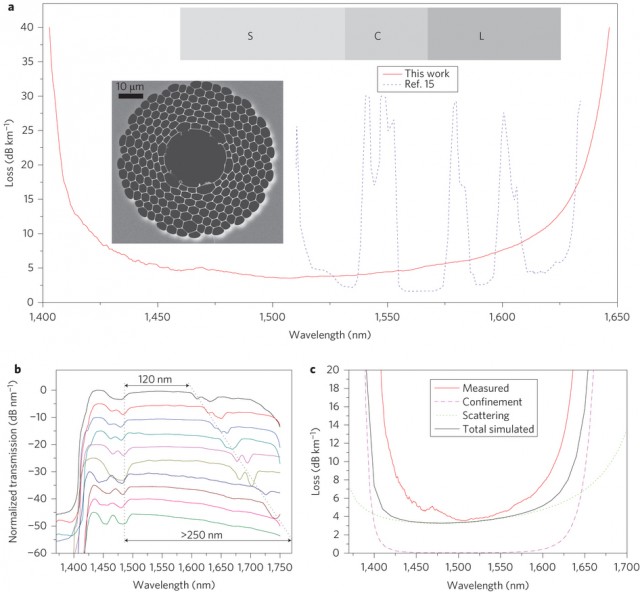Hollow fiber allows you to reduce the propagation delay by almost half
The speed of light in different environments can be quite different from the speed of light in a vacuum. Thus, in the glass used for the manufacture of modern fiber, light travels at a speed of 0.69c, that is, 31% slower. And in the air its speed hardly differs from the theoretical maximum. Researchers at the University of Southampton (England) were able to transfer 73.7 terabits of data per second at practically the speed of light in a vacuum using a hollow-core fiber created by them.
Thanks to the use of the photonic bandgap effect, they were able to reliably “lock” the light inside the fiber, achieving a combination of signal attenuation (3.5 dB / km), bandwidth (160 nm) and spectral multiplexing channels (37 40-gigabit channels on one fiber).
Image of fiber section in electron microscope and its spectral characteristics:

The signal propagation velocity was 99.7% of the speed of light in a vacuum, or almost one and a half times more than in a conventional optical fiber. The signal in such a fiber runs at 1.54 microseconds faster per kilometer, that is, when transmitting data to the opposite end of the globe, the difference will be about 30 milliseconds, which may be critical for many applications. However, until the mass use of such fibers in transcontinental cables is still far away, short sections of it in data centers of exchanges, supercomputers and other places where low levels of delays are important can appear much faster.
')
Thanks to the use of the photonic bandgap effect, they were able to reliably “lock” the light inside the fiber, achieving a combination of signal attenuation (3.5 dB / km), bandwidth (160 nm) and spectral multiplexing channels (37 40-gigabit channels on one fiber).
Image of fiber section in electron microscope and its spectral characteristics:

The signal propagation velocity was 99.7% of the speed of light in a vacuum, or almost one and a half times more than in a conventional optical fiber. The signal in such a fiber runs at 1.54 microseconds faster per kilometer, that is, when transmitting data to the opposite end of the globe, the difference will be about 30 milliseconds, which may be critical for many applications. However, until the mass use of such fibers in transcontinental cables is still far away, short sections of it in data centers of exchanges, supercomputers and other places where low levels of delays are important can appear much faster.
')
Source: https://habr.com/ru/post/174225/
All Articles